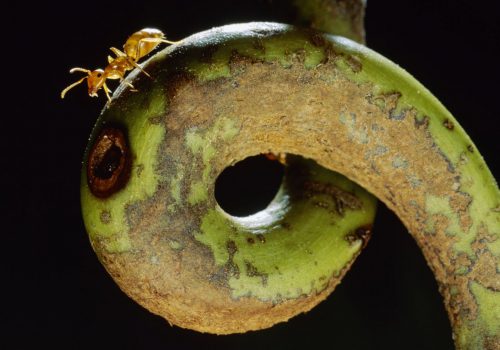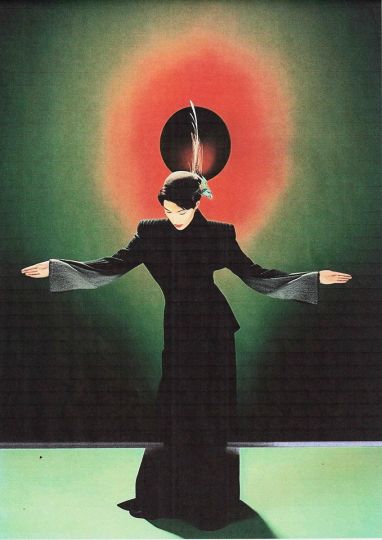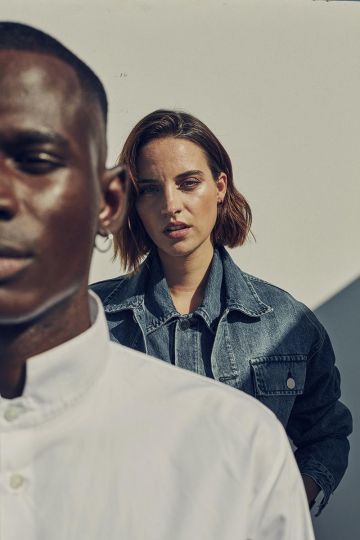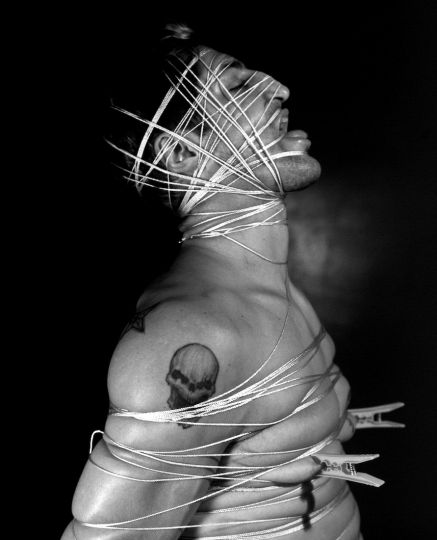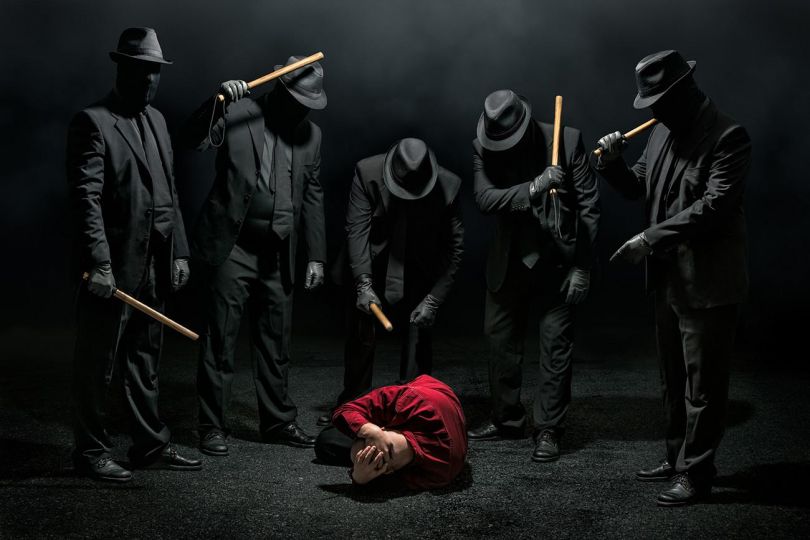Mark Moffett, PhD. is a biologist, naturalist, author and adventurer. His study of Asian ants led to his first story published by the National Geographic Magazine. He is known for studying and documenting new animal species and behaviors during his exploration in remote places in more than one hundred countries.
He is presently a Research Associate in entomology at the Smithsonian Institution and a Visiting Scholar in the Department of Human Evolutionary Biology at Harvard. Publications include: The Human Swarm, how our societies arise, thrive and fall; Adventures Among Ants; Face to Face with Frogs; and the High Frontier, exploring the tropical rainforest canopy. Exhibitions include: Farmers, Warriors, Builders, The Hidden Life of Ants at the Smithsonian Museum of Natural History was one of the most popular in its history and traveled for five years, and Face to Face with Frogs at the National Geographic Museum.
Mark Moffett will hold you spellbound with his captivating images and stories of some of the world’s smallest creatures––especially ants!
- Question: Your profession is in science and biology, how did you learn to photograph the animal and environmental world?
Moffett: As a kid, I wasn’t very interested in school, but in junior high I became obsessed with a book called The Insect Societies, full of beautiful images and esoteric words I didn’t understand. I dropped out of high school and managed to get into Beloit College, a liberal arts school in Wisconsin where I knew the professors as well as researchers at the Milwaukee Public Museum. I come from a family that rarely strayed from the U.S. Nonetheless, I seem to have an explorer’s genes—In college I sought out opportunities to work in tropical America on butterflies, beetles, lizards, and vipers. Eventually I wrote a letter to Professor Edward O. Wilson, author of my beloved The Insect Societies. He scribbled a note inviting me to visit him at Harvard when I passed through Boston. I had no understanding of how famous he was. Having gone to a small, informal school, I called him by his first name. This seemed to do no harm, since we immediately began looking at pictures of ants and telling each other stories. Stories! Right from the start.
The world is swamped with images. What’s always been in short supply are compelling stories that can be told visually. Learn a subject, that’s the best way to uncover stories that will truly surprise the viewer. The subject for me was biology, and what enticed me about Wilson was that he wasn’t just an elegant writer, now with two Pulitzers, but he had a sense of visual style that came through in the illustrations for his books even though he’s not a photographer.
As a grad student under Wilson, I nosed around the museum until I spotted specimens of an overlooked ant species that I surmised would be a terrific study subject since its workers came in a dramatic range of sizes and shapes, a sign of an intricate way of life. And, hooray! The marauder ant (as I would call it) was from Asia. I came up with a thesis plan that involved staying overseas, among the creatures that intrigued me, for as long as I could. This is when I committed to photography: I was concerned that if I returned after a protracted time with tales of ants without images to back them up, my doctoral committee might conclude that I imagined it all.
I had dabbled with a camera as an undergraduate, but macrophotography was well beyond me. I found a book about how to photograph supermodels and applied its methods to insects—fill light, hair light, and so on. I bought a used camera and $20 flashes that often gave me electric shocks. I practiced my techniques with a dead ant on a grey card in the final days before boarding a flight to Sri Lanka. Because I’d received a grant from National Geographic’s research arm, I asked if they could develop my film to save money for my fieldwork. After six months, I mailed off eight rolls, having never as yet seen a single image of mine of a living ant (this was, after all, before digital cameras). This being India, the response came by telex: the magazine was flying someone over to talk to me about my photography. It seemed my first pictures were pretty good! I asked the writer who met me to mail my developed slides back to Asia so I could see for myself what I’d done. I continued my research and photography for a total of 29 continuous months, across a dozen Asian countries—a previously unheard of length of time to escape committee meetings—before I returned to write up my Harvard degree. Before I was done, my first-ever published images—27 photographs of the marauder ant—appeared in my first published article for the National Geographic magazine. That was in 1986.
- Question: What was your process in producing that first story for National Geographic?
Moffett: I did skip a part of the tale. National Geographic had wanted to publish my story based on that initial trip. However, I knew I could do better if I returned to Asia to take pictures without thesis studies hanging over my head. I convinced the magazine to fly me to Singapore, justifying the new trip to Harvard by finishing one study at the end of my stay. For a month I worked around the clock, shooting 200 rolls—pressing that button 7,200 times. A week after mailing off that film I got a voicemail. My images “lacked critical resolution.” I wasn’t sure what that meant, though I imagined the phrase chiseled on my tombstone: Here lies Moffett. He lacked critical resolution. Calling back, I was told that all my frames were blurry. I remembered that on my arrival in Asia I’d taken my lenses to a favorite camera shop for a cleaning. Obviously, something had gone very wrong. Not to worry, National Geographic told me. The images from my last trip would do.
I hadn’t left Asia and wasn’t about to quit. My bank account was empty, so I talked my way into Canon corporate office in Singapore by explaining I was working for National Geographic and a lens had failed. Everyone there was very excited. It seemed they knew that National Geographic photographers normally used Nikons. Within the hour I left with my own new macro lens.
I must have been “in the zone” from the past month of nonstop photography since I shot pretty much the complete article with my 20 remaining rolls of film in my last four days in Asia without changing my return flight. Before I had my doctorate, National Geographic had given me an office at their headquarters in Washington, shared with the Danish photographer Sisse Brimberg.
- Question: What contributed to your early success in this field?
I think one reason for my success was my ignorance of the hurdles photographers normally face to work with National Geographic, which may have intimidated me. How did I get good images without the 10,000 hours of practice that a specialized career supposedly requires? The camera served as my microscope for observing ants. The only obligation was to press the button when anything fascinated me. Where I had accrued those 10,000 hours of experience was in my years of insect watching, which gave me the wherewithal to know when to press that button. And I stumbled on a winning tactic when I did my first National Geographic story with $300 in gear, which was, at first, because I didn’t have more money. That tactic was to keep things simple so I could concentrate on shooting fast while the action was happening. On most expeditions, my gear fits in a pack I lug on my back. I am not going to come up with the images I desire if I must assemble elaborate equipment every time I encounter an animal doing something astonishing. Simplify! From early on I glued down every button on my camera that was of no use to me.
Even though insect photography sounds specialized, back in the ‘80s there were already many good macro photographers around—I remember Olympus, which had some of the best macro gear for the field at the time, showcased a lot of this work in a newsletter. My advantage was never technique, but that I had stories to tell. Another advantage was that I photograph creatures as I see them. for me, insects are Titans. I treat the blades of grass ants move through as forests, their nests as Rome. That’s a powerful way to engage the viewer. I once exclaimed to Flip Nicklin, the famed whale photographer, that a certain spider makes mind-boggling jumps; when he asked how far, I excitedly held my fingers inches apart. Flip, who I suspect seldom needs a macro lens, burst into laughter. Heck, though, for a spider a quarter inch long that’s an extraordinary physical accomplishment, and a memorable image will portray it that way. No matter what the subject, whale or ant, you should be at its level to get such an image. Taking a photo of babies can entail descending to within a foot from the ground; for ants, I get down and dirty—literally. I am unemployed unless I’m caked in mud. The payoff, however, is crystal clear: the National Geographic editors told me my work on ants brought to mind the movie Alien.
I do have an unusual gift for one thing—keeping my lens tightly focused on tiny subjects. In Japan, I photographed samurai soldier aphids that defended siblings that were so small I had to use a half meter of extension tubes and manage a depth of field the length of a amoeba to catch them in the act. Even then, photographing in a mosquito-filled swamp, I never used a tripod. That would impede me from swiftly tracking the attacks of the killer aphids.
I came back from Japan to find multiple notes on my office door: CALL NASA. I was asked for my height and weight, grilled about how I took such extreme close-ups. I was unable to offer any special advice other than that they should locate someone with a steady hand, and they apparently gave up on the notion of me being an astronaut.
After my PhD I decided that instead of going the usual academic route and becoming a professor, I’d support myself, and the continuing research that’s always been the wellspring for most of my new stories, through photography and writing. A tricky career choice, both because my finances go up and down depending on what I’m doing, and because my fellow scientists don’t always take photography, and photographers, seriously. My approach to a career was commonplace a century ago, but nowadays we expect people to take a narrow path. The compromises I have had to make [or “the balance I’ve struck”] in pursuing my different interests mean I’m not likely to achieve top honors in either science or photography, but so be it. The excitement is finding, and pursuing, connections between science and the arts, including interdisciplinary projects and friendships with wonderful people across disciplines.
- Question: Discuss your interest in ants.
Moffett: Ants offer a hell of a lot of stories that have never been told, full of sex and violence worthy of science fiction. (Mostly violence, since only the queen gets the sex.) I knew this intuitively as a child, when many of us spent time in the muck and mire looking at ants. Most people outgrow the ant-watching urge, a darn shame. At least I showed commitment!
One reason children can’t help but watch ants is that they see all sorts of parallels to humans—instead of sitting around scratching themselves, as many mammals do for much of each day, ants are a blur of action, building roads, cooperating to gather food, waging wars—social activities of the kind that people carry out. Those similarities can be deeply informative. In one essay, “Apples and oranges, ants and humans: The misunderstood art of making comparisons,” I point out that comparing identical things would be utterly boring; the greatest eureka moments occur when similarities are spotted between things ordinarily seen as quite different. While the similarities between humans and our cousins, the chimpanzee, are often mentioned, ants parallel humans in certain respects not because they’re smart—far from it—but because they live in big societies and so have to handle problems that no chimpanzee faces in its little community—like public health emergencies. No chimp worries about sanitation, I assure you, but ants do. Subjects such as this are a rich fodder for stories, whether you’re a scientist or an artist.
Indeed, the objective of the scientist and the journalist can be alike when it comes to nature: to report on subjects that matter, even if it’s a calamity in the life of an ant. I’ve long argued that nature photography is often antiquated in this regard, in that much of what’s published year after year amounts to pretty calendar pics. As with written journalism, and science investigations, success in nature photography can come from detailing life-changing moments for the subject. I don’t deny that consummate portraiture has its place, tracing back decades to the classic studio shots in Life magazine. So, sure, any article fleshing out a creature’s story should allow for a straightforward landscape and portrait or two, and the space to chronicle its everyday activities—stalking food, raising young, that sort of thing. But dig deeper! That’s when it pays to be a biologist, leastwise in the way I think about my subject. Not that biologists are necessarily good with a camera. Still, to genuinely break new ground, don’t be the shutterbug who might as well have been a space alien, using all the craftsmanship at your disposal to document a Thanksgiving dinner while failing to understand, and convey, what that meal really means.
- Question: Describe some of the challenges in producing a story and photography on location.
Moffett: Let me address one challenge, which is to record a species going through its normal experiences under natural conditions. There’s a common belief that it’s fine to refrigerate an insect to slow it down, making it easy to focus and compose a picture. Or that it’s sensible to spend lots of money and effort building an enclosure or elaborate setup to capture a bit of action. However, anyone who knows the species in question will notice something is wrong—the activities of my marauder ants, for example, completely fall apart in captivity. Even naïve persons are excellent at telling the difference when presented with both staged images and pictures of an animal that’s simply been caught doing its thing, without manipulation.
There are instances where some artifice is unavoidable—getting intimate photos deep inside the nest of most ant species, for instance, requires putting the colony in a terrarium. But otherwise I will commit to the time necessary to capture my subject going about its typical business.
Scientists face the same sort of tradeoff. Laboratory researchers try to control everything to get precise data, a choice I call the triumph of precision over accuracy. Yet of what value is an exact figure like “the ape averaged 12.41 bouts of grooming a day” if the same individual, living free, would have groomed far more or less often, or carried out the task very differently? By comparison, fieldwork is sloppy, uncomfortable, time-consuming. Yet as a scientist, or equally as a photographer, so long as you approach the subject with care, you’ll be more confident that you’ve shown people something that bears on the normal course of that species’ existence.
I want to know how that normal existence looks… and feels! Conveying feelings is important, even in nature photography. We often hear that anthropomorphism, namely, attributing human characteristics to a creature, is bad. But you can, and should, employ what’s called critical anthropomorphism to dig into the lives of animals. Science has its roots in this sort of anthropomorphism: Our hunter-gatherer ancestors would get in the head of a game animal, imagining what it was thinking, to make testable hypotheses about its next moves. I do the same when I observe an ant in her grassroots jungle. I may sense the ant stiffen, perhaps begin to turn in my direction. I realize she has detected me. I have to hide, just as I might have to get out of view behind a tree when sneaking up on a leopard. For the ant, I don’t need to sneak behind a tree trunk—a blade of grass will do. There I wait before I give my photography another shot, with enough patience overcoming many of the challenges presented by shooting on location.
What’s essential is this: My photography captures the emotion I saw in the subject. In a strong image, say of ants battling each other, there’s an intensity you might register as anger. The tension in their bodies exists whether or not they were feeling what you imagine, which is unknowable, of course. Because the nervous system of ants and people share a common evolutionary ancestry, I, for one, am not averse to believing that some rudimentary emotions may be bouncing around in their minuscule heads. Darwin proclaimed, “The brain of an ant is one of the most marvelous atoms of matter in the world, perhaps more marvelous than the brain of man.”
- Question: What work presented the biggest difficulty?
Moffett: Of course, there’ve been problems—elephant stampedes, threats by drug lords, sitting on deadly snakes by accident. As for a body of work, though, I faced many difficulties for instance in documenting the canopy, the multi-tiered architecture of forests formed by the trees, vines, and epiphytes.
I climbed trees in many countries, eventually joining a team to scale the world’s tallest tree, a California redwood. For my original article on my treetop experiences, I was delighted that National Geographic brought on my mentor, Dr. Wilson, as author. To give Ed firsthand experience in the trees, the magazine flew him to Panama to scale a freestanding metal scaffolding used by Smithsonian scientists. I decided to ascend a tree adjacent to that tower to photograph Ed surveying the canopy. On the way up my rope, I heard a snap and was abruptly thrown upside down perhaps 100 feet from the ground. I held on for dear life, realizing the harness that attached me to the rope had come undone. Ed shouted, “Is everything all right?” I managed to call back, “Just a moment…just a moment.” I was able to pull myself upright, clip the harness back together and continue my shoot without him knowing what happened. The lesson? Never buy a safety harness that advertises a “quick release” feature. I expect that manufacturer must have gone under.
- Question: What is your process for creating a story: research and development?
Moffett: I either develop a story idea either around an ignored species I want to study myself, or after I hear of research that’s been done on a subject that has never been photographed. One of my National Geographic articles was on flies from New Guinea that fight with antlers like miniature elk, species I read about in a book by the famous 19th century explorer Alfred Wallace. With a bit of sleuthing I discovered that not much had been done with them until recently, when a biologist, Gary Dodson, filled in details about their lives that would definitely be worth photographing. From Dodson’s research I knew pretty much what I wanted in advance, though one has to allow for the unexpected. My troubles began this time with step numero uno: convincing National Geographic to approve an assignment about flies (gut response: yuck!). With no photographs of them in existence, I had to bring the editors museum specimens to prove to them how charismatic they look.
I don’t mind organizing an expedition unsure of exactly what I will find. I have a knack for tracking down rare species. Taking that risk is my adrenaline rush. Anyone putting effort into a little-known animal can make a serious contribution, that’s part of the fun of photography.
At the same time, I only pick up a camera when I have a topic in mind requiring photography as a tool for storytelling. Some of those topics have been things I treasured since childhood; I have had an exhibit at the National Geographic Museum on frogs and another at the Smithsonian Institution about ants. Others I learned about only gradually over years of email exchanges with ecologists. I’m thinking particularly of the unique ecosystems I have pursued, such as the Atlantic coastal forests of Brazil, the Hengduan mountains of China, and the Socotra archipelago.
- Question: Discuss your discoveries and new findings (new species).
Moffett: I’ve found new species of ants, frogs, and plants in different parts of the world, from places like the bottom of a sinkhole in Venezuela, and had a few of them named after me. I’ve put names to new ant species myself; however, my primary skillset isn’t taxonomy, but describing and photographing the novel animal behaviors I observe. So on my first expedition in Asia, I published on quite a few unstudied species, such as an ant with jaws like sawblades that quickly slices and dices its adversaries; another with a soldier that resembles a decapitated head (its body is so tiny that it fits in a cavity under its head); and the world’s tiniest ant. As for the marauder ant, it turned out to hunt in swarms, like an army ant, and had all sorts of other organized behaviors that looked superb on film.
- Question: What can humankind learn from the natural world: for example, ant societies?
Moffett: One of my interests is in how social behavior changes as societies get bigger, with ants and humans showing similar trends. In both, larger societies tend to have more complicated division of labor, more intricate housing and highways. Some ant colonies with a population of a million or more tackle health problems, as I said, with disinfectants used in cleaning, isolation of the sick, and special sanitation squads that cordon off material likely to harbor pathogens. In the distant past, when we lived in small bands, people didn’t have to deal with such issues, and now that there are vast populations of humans, we are still poor at handling them compared to the ant. A favorite topic of mine is mass warfare, which emerges as societies grow huge, giving them a pool of excess labor to draw from for battles; large societies of ants apply some of the same military strategies we see in humans. In an article I published in Scientific American to make this point, “Ants & the Art of War,” the photographic potential was, of course, enormous: ants pulling each other to pieces, or employing suicide bombers—individuals that literally explode on contacting an alien ant. With ants I can present all sorts of drama that would be far too over-the-top to show if humans were involved.
- Question: Discuss the importance of biodiversity and the small creatures.
Moffett: E.O. Wilson has been at the forefront in educating people about the wealth of life on Earth and the fact that so much of it is critically endangered (read, as an example, his book Half-Earth). Much of the functioning of our planet depends on arthropods, which is why the decline in insect numbers should be alarming to anyone who cares about our long-term survival.
So much of species diversity is poorly documented that journalists have literally thousands of openings to tell stories that no one has seen. Tragically nature photographers spend so much effort covering well-trodden ground—say, catching yet another panda eating bamboo, perhaps with under better lighting conditions than previously. A more laudable challenge is to make the viewer fall in love with the unexpected in nature. For me that especially includes those little underdogs that keep nature running. In talks, for example, I often describe the trials of a spider attracting a mate, a struggle I’ve laid out in photographs that any college student can relate to.
We are overwhelmed with bad news and statistics, so much so that it’s a relief to simply tune out headlines about extinctions or rainforest loss. My approach to addressing these crises is to come at them less directly, taking people by surprise. People who ordinarily hate spiders cheer for that poor male when they see my pictures. I believe that if we frame the natural world in a positive way, they’ll be better motivated to go out and save it.
- Question: What are you working on presently?
Moffett: For the last couple of years I have been virtually incommunicado as a photographer, working on my next move. The puzzle currently driving me is the life and death of societies, across species and in humans right up to the present day. What keeps a society together or breaks it apart? Such questions have led me to look at creatures as diverse as dolphins and hyenas in the field and to talk with psychologists about humans. I admit to playing the long game, working gradually toward another book and I hope a museum exhibit on a subject I consider of vast importance.
Life for me has offered exquisite opportunities for physical and intellectual adventures. Far too many young people have the impression that planet Earth has been thoroughly mapped out, explored. Those who are passionate about nature as kids grow up to find themselves in laboratories where all too often they wander out at the end of the day, blunder into a tree, and wonder what hit them. Laboratory scientists do have a lot to contribute, but there’s still much to discover out-of-doors. In these times of COVID-19, it’s essential to remember that some as yet untold nature stories can be explored right from home. Years ago, I did a National Geographic article about the acorns in my backyard, which I was delighted to learn that teachers picked up for school projects. The humble acorn is the perfect lodging place for a diversity of unseen organisms, fostering a veritable ecosystem: a grand story in a nutshell.

